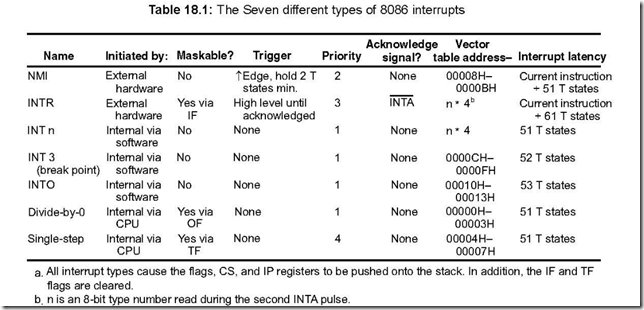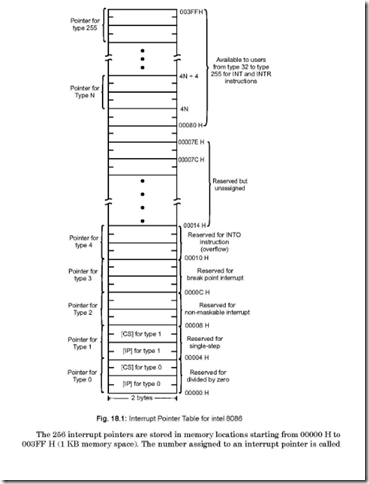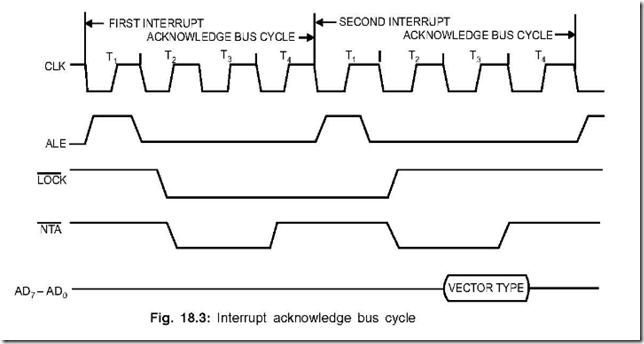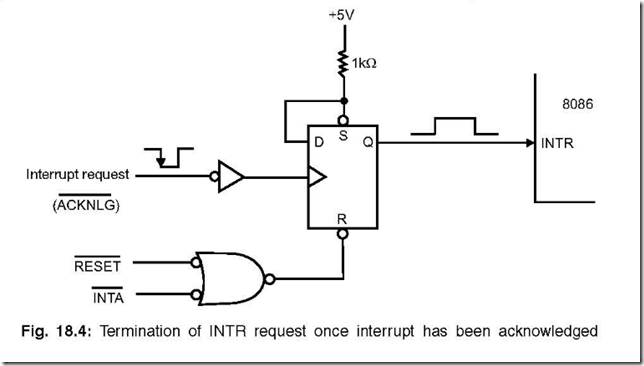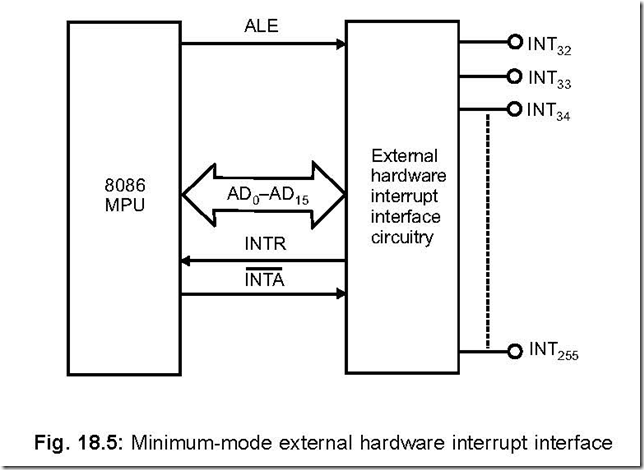8086 Interrupts
1. How many interrupts can be implemented using 8086 µP?
Ans. A total of 256 interrupts can be implemented using 8086 µP.
2. Mention and tabulate the different types of interrupts that 8086 can implement. Ans. 8086 µP can implement seven different types of interrupts.
z NMI and INTR are external interrupts implemented via Hardware.
z INT n, INTO and INT3 (breakpoint instruction) are software interrupts implemented
through Program.
z The ‘divide-by-0’ and ‘Single-step’ are interrupts initiated by CPU.
Table 18.1 shows the seven interrupt types implemented by 8086.
3. Distinguish between the two hardware interrupts of 8086.
Ans. The distinction between the two hardware interrupts of 8086 are as follows, shown in Table 18.2.
Table18.2: Comparison of NMI and INTR interrupts
|
NMI |
INTR |
|
1. Non-maskable type. 2. Higher priority. 3. Edge triggered interrupt initiated on Low to High transition. 4. Must remain high for more than 2 CLK cycles. 5. The rising edge of NMI input is latched on-chip and is serviced at the end of current instruction. 6. No acknowledgement. |
1. Maskable type. 2. Lower priority. 3. Level triggered interrupt. 4. Sampled during last CLK cycle of each instruction. 5. No latching. Must stay high until acknowledged by CPU. 6. Acknowledged by INTA output signal. |
4. How many bytes are needed to store the starting addresses of ISS for 8086 µP? Ans. 8086 µP can implement 256 different interrupts. To store the starting address of a single ISS (Interrupt Service Subroutine), four bytes of memory space are required—two bytes
to store the value of CS and two bytes to store the IP value. Thus to store the starting address of 256 ISS, in all 256 × 4 = 1024 bytes = 1 KB will be required.
5. Indicate the number of memory spaces needed in stack when an interrupt occurs.
Ans. When an interrupt occurs, before moving over to starting address of the corresponding ISS, the following are pushed into the stack: the contents of the flag register, CS and IP. Since each one of the three are 2 bytes, hence a total of 6 bytes of memory space is needed in the stack to accommodate the flag register, CS and IP contents.
6. What are meant by interrupt pointer and interrupt pointer table?
Ans. The starting address of an ISS in the 1 KB memory space is known as the interrupt pointer or interrupt vector corresponding to that interrupt.
The 1 KB memory space needed to store the starting addresses of all the 256 ISS is called the interrupt pointer table.
7. Write down the steps, sequentially carried out by the systems when an interrupt occurs.
Ans. When an interrupt occurs (hardware or software), the following things happen:
z The contents of flags register, CS and IP are pushed on to the stack.
z TF and IF are cleared which disable single step and INTR interrupts respectively.
z Program jumps to the starting address of ISS.
z At the end of ISS, when IRET is executed in the last line, the contents of flag register,
CS and IP are popped out of the stack and placed in the respective registers.
z When the flags are restored, IF and TF get back their previous values.
8. Draw and discuss the interrupt pointer table for 8086 µP. Ans. The interrupt pointer table for 8086 is shown in Fig. 18.1.
The 256 interrupt pointers are stored in memory locations starting from 00000 H to 003FF H (1 KB memory space). The number assigned to an interrupt pointer is called
the Type of the corresponding interrupt. As for example, Type 0 interrupt, Type 1 interrupt … Type 255 interrupt. Type 0 interrupt has a memory address 00000 H, Type 1 has a memory address 00004 H, while Type 255 has a memory address 003FF H. The first five pointers (Type 0 to Type 4) are dedicated pointers used for divide by zero, single step, NMI, break point and overflow interrupts respectively. The next 27 pointers (Type 5 to Type 31) are reserved pointers—reserved for some special interrupts. The remaining 224 interrupts—from Type 32 to Type 255 are available to the programmer for handling hardware and software interrupts.
9. Discuss the priority of interrupts of 8086.
Ans. 8086 tests for the occurence of interrupts in the following hierarchical sequence:
z Internal interrupts (divide-by-0, single step, break point and overflow)
z Non-maskable interrupt—via NMI
z Software interrupts—via INTn
z External hardware interrupt—via INTR
Hence, internal interrupts belong to the highest priority group and internal hardware
interrupts are the lowest priority group. Again, different interrupts are given different
priorities by assigning a type number corresponding to each priority—starting from
Type 0 (highest priority interrupt) to Type 255 (lowest priority interrupt). Thus, Type 40
interrupt is having more priority than Type 41 interrupt. If we presume that at any
instant a Type 40 interrupt is in progress, then it can be interrupted by any software
interrupt, the non-maskable interrupt, all internal interrupts or any external interrupt
with a Type number less than 40.
10. Outline the events that take place when 8086 processes an interrupt.
Ans. Fig. 18.2 shows the manner in which 8086 processes an interrupt while the following are the events that take place sequentially when the processor receives an interrupt (from an external device via INT 32 through INT 255:
z Receiving an interrupt request (from an external device)
z Generation of interrupt acknowledge bus cycles.
z Servicing the Interrupt Service Subroutine (corresponding to the external device
which has interrupted the CPU.)
Again the difference between simultaneous interrupt and interrupt within an ISS is
to be understood. Occurrence of more than one interrupt within the same instruction is
called simultaneous interrupt while if an interrupt occurs while the ISS is in progress,
it is an interrupt occurring within an ISS.
Internal interrupts (except single step) have priority over simultaneous external
requests. For example, let the current instruction causes a divide-by-zero interrupt when
an INTR (a hardware interrupt) occurs, the former will be serviced. Again, if
simultaneous interrupts occur on INTR and NMI, then NMI will be serviced first.
For simultaneous interrupts occurring, the priority structure of Fig.18.2 will be
honoured, with the highest priority interrupt being serviced first.
Although it has been commented that software interrupts get priority over external
hardware interrupts, even then if an interrupt on NMI occurs as soon as the interrupt’s
ISS begins, it (i.e., NMI) will be recognised and hence serviced.
11. List the different interrupt instructions associated with 8086 µP.
Ans. Table 18.3 lists the different interrupts of 8086 µP along with a brief description of their
functions.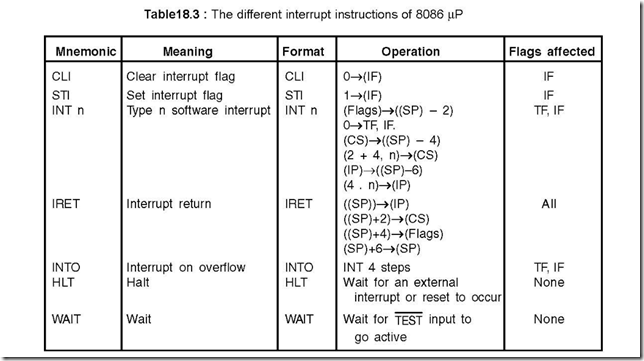 12. Show the internal interrupts and their priorities.
12. Show the internal interrupts and their priorities.
Ans. The internal interrupts are: Divide-by-0, single step, break point and overflow corresponding to Type 0, Type 1, Type 3 and Type 4 interrupts respectively.
Since a type with lesser number has higher priority than a type with more number, thus the mentioned internal interrupts can be arranged in a decreasing priority mode, with highest priority mentioned first: Divide-by-0, single step, break point, overflow.
13. What are the characteristics associated with internal interrupts? Ans. The following are the characteristics associated with internal interrupts:
z The interrupt type code is either contained in the instruction itself or is predefined.
![]() z No INTA bus cycles are generated, as in the case of INTR interrupt input.
z No INTA bus cycles are generated, as in the case of INTR interrupt input.
z Apart from single step interrupt, no other internal interrupt can be disabled.
z Internal interrupts, except single step have higher priority than external interrupts.
14. Discuss the two interrupts HLT and WAIT.
Ans. On execution of HLT (halt) instruction by 8086, CPU suspends its instruction execution and enters into an idle state. It waits for either an external hardware interrupt or a reset input (interrupt). When any one of these occurs, CPU starts executing again.
When the WAIT instruction is executed by 8086, it internally checks the logic level
![]()
![]()
![]() existing at its TEST input. If TEST is at logic 1 state, then CPU goes into an idle state. When TEST input assumes a zero state, execution resumes from the next sequential
existing at its TEST input. If TEST is at logic 1 state, then CPU goes into an idle state. When TEST input assumes a zero state, execution resumes from the next sequential
![]() instruction in the program. TEST input is normally connected to the BUSY output signal of 8087 NDP.
instruction in the program. TEST input is normally connected to the BUSY output signal of 8087 NDP.
15. Mention the addresses at which CS40 and IP40 corresponding to vector 40 would be stored in memory.
Ans. INT 40, for its storage, requires four memory locations—two for IP40 and two for CS40.
The addresses are calculated as follows:
|
4 × 40 = 160 10= 1010 0000= A0 H.
|
Thus, IP40 is stored starting at 000A0 H and CS40 is stored starting at 000A2 H.
16. Explain in detail the external hardware interrupt sequence.
Ans. The external device can request for service via INT 32 through INT 255 by pulling the corresponding INT n (n = 32 to 255) high. The interrupt request gives rise to generation of interrupt acknowledge bus cycles and then moving into ISS corresponding to the device which has interrupted the system. The presently requested interrupt is recognised provided no higher priority interrupt is pending and IF is already set via software.
Once the interrupt is recognised (since for any INTR to be recognised, the corresponding INT must stay high till the last clock cycle of the presently executed instruction). 8086 initiates interrupt acknowledge bus cycles, shown in Fig. 18.3.
During T1 of the first interrupt bus cycle, ALE is put to low state and remains so till the end of the cycle. During the whole of this cycle, address/data bus is driven into
![]() Z-state. During T2 and T3 of this first interrupt bus cycle, INTA is put to low state— indicating that the request for service has been granted so that the requesting device can withdraw its high logic which is connected to INTR pin 8086.
Z-state. During T2 and T3 of this first interrupt bus cycle, INTA is put to low state— indicating that the request for service has been granted so that the requesting device can withdraw its high logic which is connected to INTR pin 8086.
LOCK signal is of importance only in maximum mode. This signal goes low during T2 of the first INTA bus cycle and is maintained in zero state until T2 of the second INTA bus cycle.
8086 is prevented from accepting a HOLD request. The LOCK output, in conjunction with external logic, is used to lock off other devices from the system bus. This ensures completion of the current interrupt till its completion.
During the second interrupt bus cycle, the external circuit puts in the interrupt code
(3210 = 20 H through 25510 = FF H) on the data bus AD0– AD7 during T3 and T4 and is read by 8086.
Before moving to ISS, CPU saves the contents of the flag register along with the current CS and IP values. Now by reading the number from the data bus, the corresponding CS and IP values are placed in them (for instance, if the external device has interrupted via INT 60, then CS60 and IP60 would be loaded into CS and IP register
respectively). Thus the ISS would be run to its completion because before moving into
ISS, IF and single-stepping have been disabled.
In the last line of ISR, an IRET instruction is there, which on its execution pops the old CS and IP values from the stack and put them in CS and IP registers. This thus ensures that the main program starts at the very memory location that was left off because of ISS.
17. Indicate two applications where NMI interrupt can be applied.
Ans. NMI is a non-maskable hardware interrupt, i.e., it cannot be masked or disabled. Hence, it is used for very important system exigencies like (a) detection of power failure or
(b) detection of memory read error cases.
18. Draw a circuit that will terminate the INTR when interrupt request has been acknowledged.
Ans. Fig. 18.4 makes INTR input of 8086 to go into 1 state once the interrupt request comes from some external agency. The falling edge of the peripheral clocks the flip-flop which
![]() makes INTR to become 1. The first INTR pulse then resets Q, making INTR to become
makes INTR to become 1. The first INTR pulse then resets Q, making INTR to become
0. This ensures that no second interrupt request is recognised by the system. The reset input sees to it that INTR remains in the 0 state when the system is reset.
19. Discuss the following (a) Type 0 interrupt (b) Type 1 interrupt (c) Type 2 interrupt (d) Type 3 interrupt and (e) Type 4 interrupt.
Ans. (a) Type 0 interrupt (or Divide-by-zero interrupt)
If the quotient resulting from a DIV (divide) instruction or an IDIV (integer divide) instruction is too large such that it cannot be accommodated in the destination register, a divide error occurs. Then 8086 perform a Type 0 interrupt. This then passes the control to a service subroutine at addresses corresponding to IP0 and CS0 at 0000 H and 0002 H respectively in the pointer table.
(b) Type 1 interrupt (Single Step interrupt)
The single step interrupt will be enabled only if the trap flag (TF) bit is set (= 1). The TF bit can be set/reset by software.
Single step control is used for debugging in assembly language. In this mode the processor executes one instruction and then stops. The contents of various registers and memory locations can be examined. If the results are found to be ok, then a command can be inserted for execution of the next instruction. Trap flag cannot be set directly. This is done by pushing the flags on the stack, changes are made and then they are popped.
(c) Type 2 interrupt (non-maskable NMI interrupt)
Type 2 interrupt is the non-maskable NMI interrupt and is used for some emergency
situations like power failure. When power fails, an external circuit detects this and
sends an interrupt signal via NMI pin of 8086. The DC supply remains on for atleast 50 ms via capacitor banks so that the program and data remaining in RAM locations can be saved, which were being executed at the time of power failure.
(d) Type 3 interrupt (break point interrupt)
Type 3 interrupt is a break point interrupt. The program runs up to the break point
when the interrupt occurs. This is achieved by inserting INT 3 at the point the break
is desired. The ISS corresponding to Type 3 interrupt saves the register contents in the stack and can also be displayed on CRT and the control is returned to the user. This is used as a software debugging tool, like single stepping method.
(e) Type 4 interrupt (overflow interrupt)
The software instruction INTO (interrupt on overflow) is inserted in a program
immediately after an arithmetic operation is performed. Insertion of INTO implements
a Type 4 interrupt. When the signed result of an arithmetic operation on two signed numbers is too large to be stored in the destination register or else in a memory location, an overflow occurs and the OF (overflow flag) is set. This initiates INT4 instruction and the program control moves over to the starting address of the ISS, which corresponds to IP4 and CS4. These two are stored at address locations 0010 H and 0012 H respectively.
20. In what way the INTO instruction is different from others?
Ans. The INTO instruction is different in that no type number is needed to be mentioned.
To explain the difference, for executing any INT instruction, type no. is needed, like
INT 10, INT 23, etc.
To explain further,
|
Opcode |
Operand |
Object Code |
Mnemonic |
|
INT INTO |
Type none |
CD 23 CE |
INT 23 H (assuming Type 23 H is employed) INT |
21. Draw the schemes of (a) Min and (b) Max mode 8086 system external hardware interrupt interface and explain.
Ans. (a) The scheme of interconnections of Min-mode 8086 system external hardware interrupt interface is shown below in Fig. 18.5.
The interconnecting signals to be considered for 8086 are ALE, INTR, INTA and the data bus AD0 – AD15.
The external device requests the service of 8086 via the INTR line. INTR is level triggered and must stay at logic 1 until recognised by the processor. Two interrupt acknowledge bus cycles are generated in response to INTR. At the end of the first bus
cycle, the INTR should be removed so that it does not interrupt the 8086 a second time and the ISS can run without interruption. In this second bus cycle CPU puts the type number on the data bus of the active interrupt.
(b) The scheme of interconnections of Max-mode 8086 system external hardware interrupt interface is shown below in Fig. 18.6.
In this mode, the bus controller IC 8288 generates the INTA and ALE signals. INTA is generated when at the input of 8288, a status 000 H is applied via the status lines S2 S1 S0 .
The LOCK signal in the figure is the bus priority lock signal and is the input to
bus arbiter circuit. This circuit ensures that no other device can take control of the system buses until the presently run interrupt acknowledge cycle is completed.
